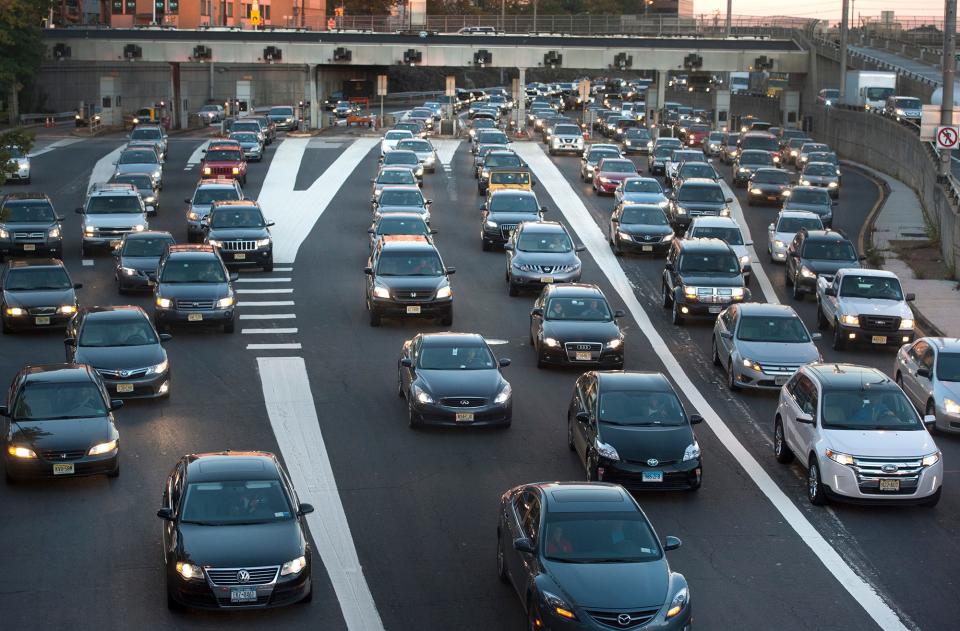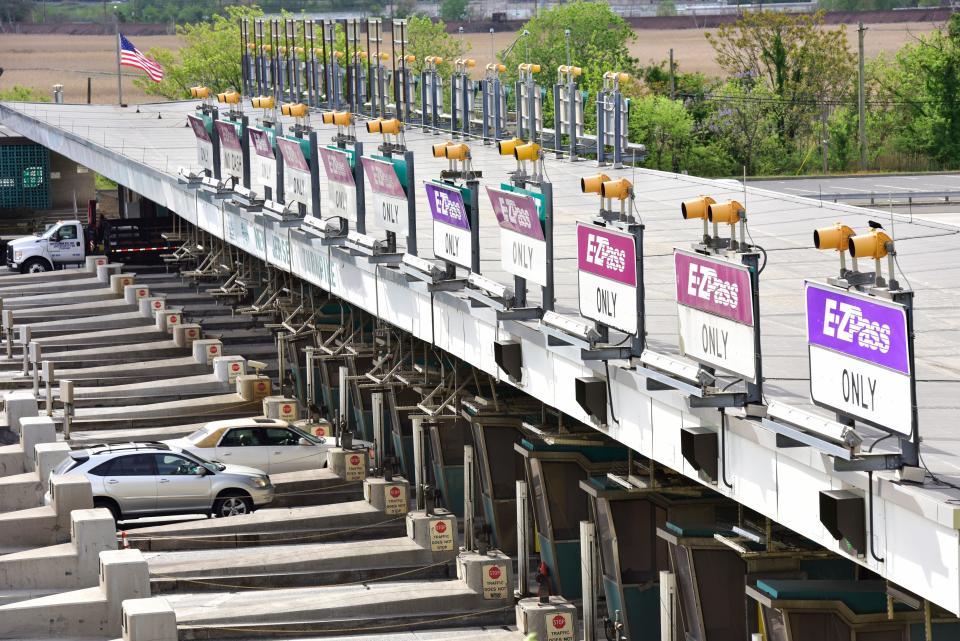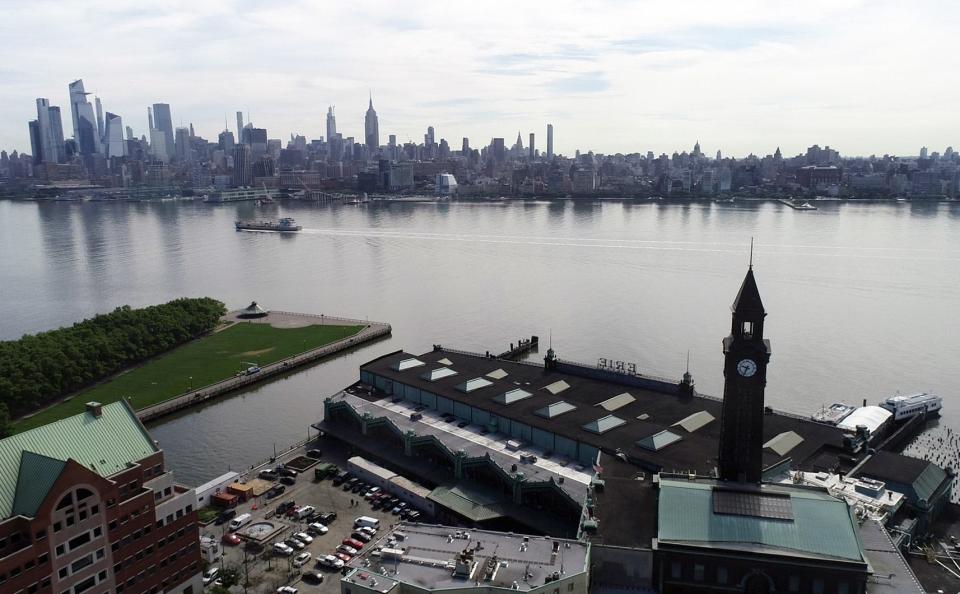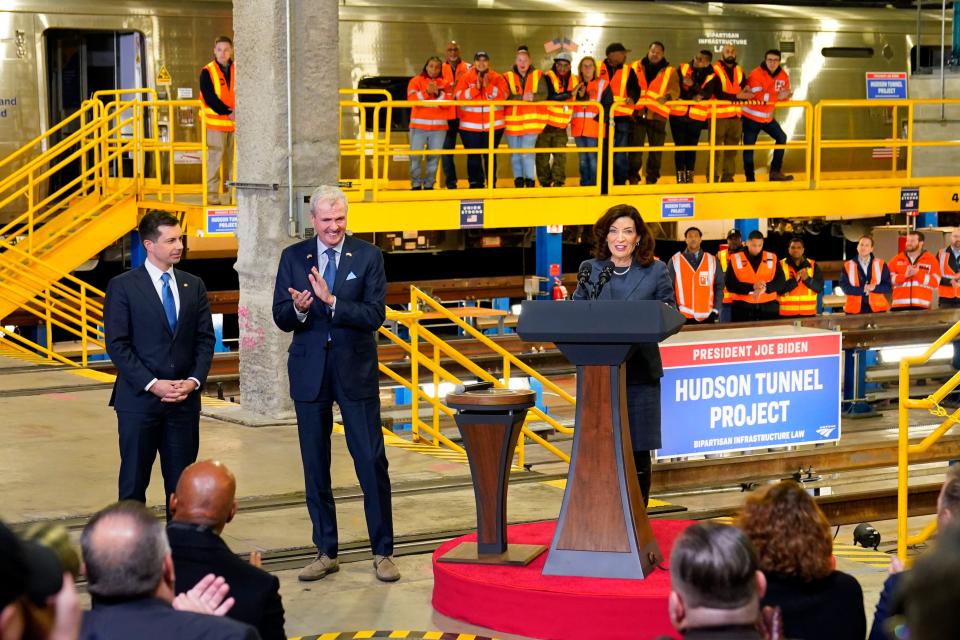What is congestion pricing? Answering all your questions about toll program for NJ drivers
- Oops!Something went wrong.Please try again later.
News that the federal government approved the first-in-the-nation congestion pricing program was dumped on the New York City region last Friday around 5 p.m.
Despite the happy-hour timing of the announcement, it didn’t go unnoticed and it certainly didn’t make everyone happy — particularly those in New Jersey, who are bracing for yet another toll.
Gov. Phil Murphy voiced his outrage over the plan — even though he’s not 100% against it in the future — and has threatened to look into legal options. But proponents of the plan say there’s no reason to panic, as details of how the program will work are still being figured out.
Here is what we know about congestion pricing, how it will affect New Jersey drivers and what we don’t yet know about the program.
What is congestion pricing?

The plan in New York, guided by the Metropolitan Transportation Authority, would create a new tolling perimeter around what’s known as the central business district, or the area below 60th Street in Manhattan, not including the FDR Drive and the West Side Highway.
The idea of congestion pricing dates back at least to 1976, when it was adopted in Singapore to cut down on vehicle traffic and pollution and improve public transportation into its busiest region — all of which was achieved. These are the same principles that guided congestion tolling programs in Sweden, London and now New York City.
The program was first approved in 2019 by the New York Legislature, which by law required the MTA to collect about $15 billion, or $1 billion annually, to support the agency’s capital plan. About 80% of those toll dollars will go toward subway and bus projects, with 10% directed to Long Island Rail Road territory and another 10% to Metro-North.
Who is in charge of the program?

The MTA's Triborough Bridge and Tunnel Authority (TBTA) will “design, develop, build, and run the Central Business District (CBD) Tolling Program,” according to the MTA. However, a six-member Traffic Mobility Review Board will recommend to the TBTA board what it thinks the tolling rates should be, what vehicles should be eligible exemptions and whether any credits should go into effect.
The review board has not yet announced its first meeting, but the MTA said its "process will be a public process."
How much will congestion pricing cost me?
This is one of the many questions that won’t be answered until the Traffic Mobility Review Board begins its work. However, last year, the MTA produced a more than 4,000-page environmental review that studied seven tolling scenarios in which the automobile tolls ranged from $9 to $23 during peak hours, $7 to $17 during off-peak hours, and $5 to $12 overnight.
The larger the toll, the more credits and exemptions were offered in those scenarios; smaller tolls had little to no credits and exemptions.
Will New Jersey drivers get a credit because they already pay a toll to get into Manhattan?
That is also among the questions that will be decided by the Traffic Mobility Review Board. The law dictates that those who live within the CBD and earn less than $60,000 will be eligible for a state tax credit for tolls paid and that qualifying emergency vehicles and those transporting people with disabilities will be exempt from the charge.
But the review board will have the latitude to determine whether others — including New Jersey drivers — should also receive credits or exemptions. For example, in three of the seven tolling scenarios, drivers using the Lincoln and Holland tunnels would receive a credit for tolls already paid using those tunnels. In one of the scenarios studied, those two tunnels and drivers crossing the Hudson River using the George Washington Bridge would receive a credit. None of the scenarios laid out in the report would fully credit drivers using Hudson River crossings for tolls paid before reaching the CBD.
Kate Slevin, executive vice president of the Regional Plan Association — a research and advocacy nonprofit that studies transportation, housing and climate issues in New York, New Jersey and Connecticut — said she is optimistic that “an agreement can be reached that’s acceptable to both states,” adding that “there’s a case to be made for credit on the Hudson River crossings.”
Another question is whether buses — be they private charters or those on public transportation routes — should be exempt. Two of the seven tolling scenarios exempt all buses, and a third scenario exempts only transit buses, like those operated by the MTA and NJ Transit, and buses contracted out by a public agency.
NJ news Developer cancels Nabisco factory implosion in favor of 'alternate method of demolition'
When will this go into effect?
The MTA’s goal is reportedly April 2024. However, that’s an ambitious timeline, given that so many details still have to be worked out, a federal public involvement process has to be followed and the MTA will have to construct what will likely be overhead poles equipped with all-electronic cashless tolling technology.
Is congestion pricing all bad? Or is it all good?
It depends on who you talk to.
Slevin says the federal approval of the plan is a “huge victory for public transportation, for our health and our environment.”

“The MTA is using 100% of the revenues to invest in the transit system, and that’s good for the majority of people who travel from New Jersey into Manhattan for work,” Slevin said, noting that most people also use the city subways and buses. “For drivers, the congestion pricing is really meant to manage congestion and improve traffic. It should be a smoother ride for drivers as well.”
Plus, Slevin said, creating a more equitable tolling system should reduce driving time, so drivers can take the shortest, most convenient route instead of “toll shopping,” which is when drivers go out of their way to take the cheapest route instead of the most direct one.
U.S. Rep. Josh Gottheimer, who represents parts of North Jersey and is one of the Garden State’s biggest opponents of congestion pricing, criticizes the plan for not directly benefiting New Jersey’s public transportation system and for potentially shifting traffic to outer regions, including Bergen County.
“The congestion tax will send more trucks into northern New Jersey by the GW Bridge and into the outer boroughs, to areas just outside of the tolling zone — hurting lower-income families,” Gottheimer said.
Does this mean more people will be on my train, bus and ferry into Manhattan?
That’s certainly possible — and it’s one of the goals of the program. However, the increase in public transportation usage in New Jersey is predicted to be minimal, according to the MTA’s environmental review.
The vast majority of people commuting into Manhattan from New Jersey already use public transportation; only 3% use cars, the MTA said.
“The actual growth projected on NJ Transit or PATH for any of the scenarios is 1 or 2 percentage points at the max,” Slevin said.
Among the concerns raised is that capacity-increasing projects for public transportation across the Hudson River — like a new Port Authority Bus Terminal and New York Penn Station, which are both over capacity — are still in the early stages and years away from being built.
But Slevin said ridership on public transportation remains below the levels seen before the pandemic, so that shouldn’t be a concern in the near term. Long-term, improving public transportation through those projects and others will be critical and highlight the need for congestion-reducing measures.
“Looking forward, the region’s going to keep growing. More and more people are going to be on our transit network, so there’s absolutely the need to monitor it,” Slevin said.
What legal actions could New Jersey lawmakers be considering?

That’s not totally clear.
The approval New York received last week from the Federal Highway Administration was that of “legal sufficiency."
Murphy, however, seemed to think that could be challenged and said in a statement released Friday that officials are “closely assessing all legal options.”
He added that they would “keep working closely with partners from both states and both sides of the aisle, including Congressman Gottheimer and our congressional delegation, to halt implementation of this misguided tolling plan.”
A Murphy administration official told NorthJersey.com that the legal options include litigation challenging the U.S. Transportation Department's approval of the program. The governor has also threatened in the past to veto Port Authority of New York and New Jersey minutes, which could essentially halt some activity and construction at the bistate agency that oversees the region’s three major airports, a number of tunnels and bridges, PATH and the ports.
What could the political ramifications be?

Murphy and Gov. Kathy Hochul, of New York, have spent the last almost two years trying to rewrite the narrative between the two states, appearing at multiple events together patting each other on the back about how they are getting along and getting things done — an exercise on display just hours before the news became public about the congestion pricing approval.
Despite the public displays of affection and collaboration, not all transportation issues have been hunky-dory, and congestion pricing is just one example.
New Jersey won a U.S. Supreme Court case earlier this year after New York sued it for attempting to withdraw from the bistate agency that for decades has monitored labor hiring and the influence of organized crime at the ports.
The two states and Connecticut were locked in a months-long stalemate over how to split federal transportation funds — a debate in which congestion pricing was briefly mentioned as a bargaining chip — that ultimately favored New York by $850 million when compared with how the federal formula would have divvied up the money.
There are also lengthy negotiations taking place between the Hudson River states about the finer details of the Gateway program, the multibillion-dollar series of projects that would increase and rehabilitate rail tunnels between the two states, repair or replace a series of bridges and improve New York Penn Station. However, in the last year, multiple agreements have been signed to advance these projects and each state has set aside dollars to fund the bistate agency overseeing the projects.
This article originally appeared on NorthJersey.com: Congestion pricing NYC: Questions answered for toll program

